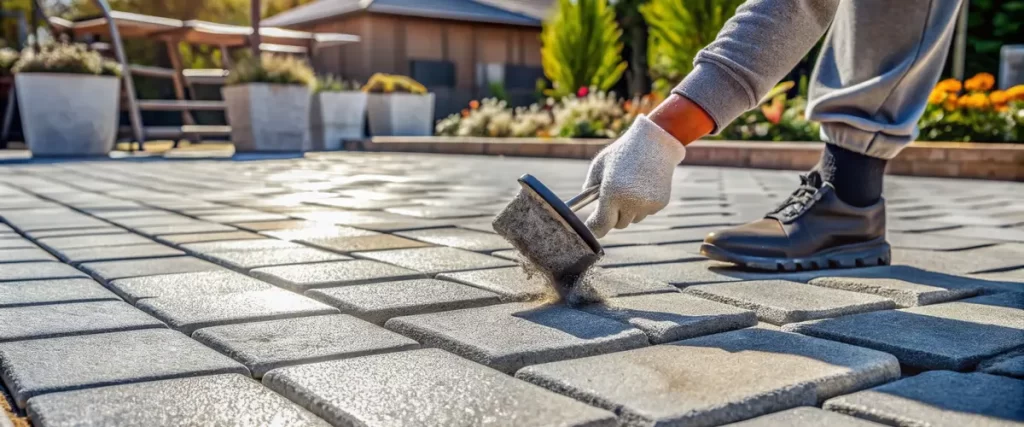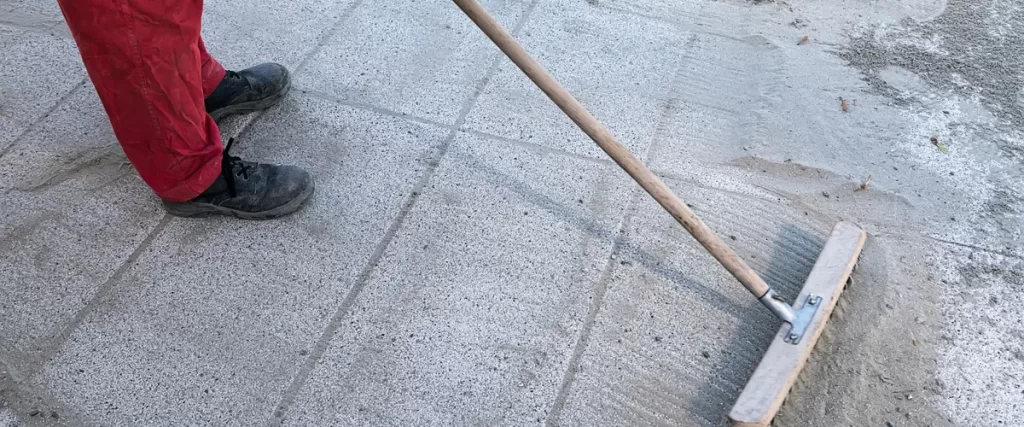Creating a long-lasting and sturdy patio or walkway starts with the right materials. Choosing the best polymeric sand for pavers makes all the difference. This sand isn’t just about filling gaps; it keeps your pavers secure and helps avoid common headaches like weed growth and shifting. Let’s dive into how polymeric sand can take your paver projects from good to great, turning them into durable, low-maintenance spaces you’ll love.

What Is Polymeric Sand?
Polymeric sand is a mix of fine sand and special binders, like silica. Once you spread it into your paver joints and activate it with water, it hardens into a solid surface. This keeps your pavers locked in place while blocking out weeds and even pests. Whether you’re using concrete pavers or clay pavers, polymeric sand is a must-have finishing touch to keep everything neat and in place.
Why Use Polymeric Sand for Paver Projects?
Polymeric sand does more than make your patio look polished – it’s all about making it functional and long-lasting. Here’s why it’s a game-changer for your paver projects:
- Keeps Pavers Steady: It prevents your pavers from shifting under pressure or heavy rain.
- Stops Weeds: Sealed gaps mean no more pulling weeds out of tiny cracks.
- Erosion Protection: Unlike basic paver sand, polymeric sand won’t wash away in storms.
- Adds Durability: It reinforces your paver surfaces, so they last longer without extra maintenance.
Choosing the Best Polymeric Sand
Finding the best polymeric sand depends on your project’s specific needs and the type of pavers you’re working with. Here are some solid options to consider:
- Dominator Polymeric Sand: Loved for its durability and ease of use, this sand works well on a variety of paver surfaces and comes in different colors to match your patio.
- Techniseal Polymeric Sand: Known for its strong binding power, Techniseal excels at preventing weed growth, especially in wider paver joints.
- Gator Maxx G2: Ideal for high-traffic areas, this sand resists UV rays and erosion, making it perfect for outdoor spaces that need extra toughness.
When comparing polymeric sand manufacturers, think about how easy the product is to apply and how well it will hold up over time. Pay attention to the joint width of your pavers, as some sands are better for narrow gaps while others suit wider spaces.
How to Apply Polymeric Sand for Pavers
Applying polymeric sand is straightforward, but attention to detail makes all the difference. Here’s how to do it right:
- Clean Your Paver Surface: Remove dirt, debris, and any leftover sand from the surface.
- Spread the Sand: Pour the polymeric sand over your pavers, then use a broom to push it into the joints.
- Compact the Sand: Use a tamper to ensure the sand fills every gap.
- Sweep Excess Sand: Remove extra sand from the surface to avoid a cloudy finish.
- Wet the Area: Gently mist water over the area to activate the sand. Be careful—too much water can wash it away.
Follow these steps, and you’ll have a solid, long-lasting surface that’s ready for anything.
Best Practices for Polymeric Sand
Want the best results? Here are a few tips to keep in mind:
- Match the Sand to Your Pavers: Different sands work better with specific paver types, like natural stone or concrete pavers.
- Check the Weather: Don’t apply polymeric sand on a rainy day—it needs dry conditions to harden properly.
- Watch Your Water Usage: Too much water can ruin the sand, while too little won’t activate it.
Pros and Cons of Polymeric Sand
Polymeric sand is a great tool, but it’s not without its challenges. Here’s a quick look at what to expect:
Pros:
- Stabilizes pavers, keeping them steady.
- Prevents weed growth and reduces maintenance.
- Long-lasting and more durable than regular paver sand.
- Creates clean, polished joints that look professional.
Cons:
- Requires precise application for the best results.
- Costs more than traditional paver sand.
- Once it hardens, it can’t be reused or removed easily.
Maintaining Your Polymeric Paver Patio
Keeping your patio looking great doesn’t take much effort. Here’s what you should do:
- Clean Regularly: Sweep or use a leaf blower to keep debris off the paver surfaces.
- Check for Cracks: Look for gaps or cracks in the paver joints and reapply sand as needed.
- Consider Sealing: Applying a paver sealant adds extra protection and enhances the look of your patio.
Alternatives to Polymeric Sand
If polymeric sand doesn’t fit your project, there are other options:
- Jointing Sand: A simpler option for smaller projects, though it’s not as durable.
- Organic Mulch: Great for garden beds or non-walkable areas, but not ideal for patios or pathways.
- Crushed Gravel: Provides excellent drainage but doesn’t offer the solid finish of polymeric sand.
When to Use Polymeric Sand
Polymeric sand is a no-brainer for patios, walkways, or driveways with concrete or clay pavers. It keeps everything in place, even in areas with heavy foot traffic. Plus, it saves you from pulling weeds out of paver joints – a win for anyone who’s tired of endless yard work.
How to Fix Common Polymeric Sand Problems
Even with polymeric sand, things don’t always go perfectly. Here’s how to tackle some common issues:
- Cloudy Pavers: Haze on your pavers? A quick scrub with a paver cleaner will fix that.
- Cracked Joints: If the sand cracks, sweep in more sand and lightly spray water to patch it up.
- Washed-Out Sand: If rain washes the sand away before it sets, just reapply and activate it with water—gently this time!
Using Polymeric Sand for Putting Greens and Pet Turf
If you’re working on putting greens or pet turf, polymeric sand is a game-changer. It keeps putting greens smooth for perfect shots and holds pet turf in place, making cleanup a breeze. It’s practical and low-maintenance, whether you’re playing golf or caring for furry friends.
How It Works with Different Paver Types
Polymeric sand works with more than just concrete pavers. It’s great for clay pavers and natural stone too. Just pick the right sand for your project – coarse sand for wide gaps, fine sand for tight joints – and always check the product label to be sure.
Where to Buy the Best Polymeric Sand
You can find polymeric sand at most home improvement stores. Dominator polymeric sand and Techniseal polymeric sand are two trusted brands. For bigger projects, check if local suppliers offer bulk options. The key is matching the sand to your paver type and joint width.
FAQs About Polymeric Sand
What is the best polymeric sand for pavers?
Dominator and Techniseal are great options for durability and ease of use.
Can I use polymeric sand for clay pavers?
Yes, it works well as long as you choose the right type for your joint width.
How do I remove excess sand after applying polymeric sand?
Sweep it away before wetting the surface – it’s that simple.
Does polymeric sand prevent weed growth?
Yes, it hardens to block weeds from sprouting in paver joints.
Can polymeric sand be used with natural stone?
Absolutely, it’s versatile enough for natural stone projects too.

The Final Step to a Perfect Patio or Walkway
Polymeric sand is the secret to building patios and walkways that last. Whether you’re starting fresh or updating an existing space, choosing the best polymeric sand is key to ensuring durability, stability, and a polished look. With trusted brands like Dominator and Techniseal, your project is set for success.
Ready to create the patio or walkway of your dreams? Contact Land Designs by Colton today, and let’s bring your vision to life with precision and expertise! Get in touch today, and let’s upgrade your space!
